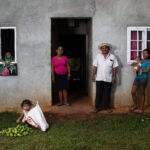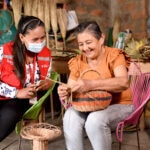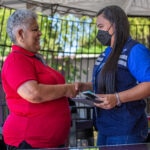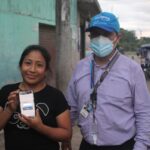15 years of microfinance: a successful formula for inclusion in Latin America
In the past 15 years, around 1.5 billion adults have been included in the financial system, where microfinance has played a key role. Giovanni di Plácido, director of Analysis and Research for BBVA Microfinance Foundation (BBVAMF), recounts the creation of loans and monetary transactions to the advent of microfinance as a formula for inclusion, and the Foundation's leading role in the transformation of this sector in its 15 years of activity.

One of the most disruptive events in the shaping of modern societies was the rise of trade in the 11th century, thanks to innovations that favored increased production. All this led to a rapid population growth and the first wave of a new welfare.
Cities arose mainly in places where the greatest number of people converged, and they tended to be close to the ports. Thanks to this upturn, the population started to migrate from the countryside to urban dwellings, which gave rise to new cities as well as the resurgence of old ones. The first merchants and artisans began to group together, with the few that already existed in the urban centers.
This pre-modern trade revolved around credit and no one was spared the necessity of being a debtor and/or creditor. Cloth merchants bought wool on credit, had weavers make it into cloth on credit, and then sold it on credit at international fairs and in urban trading centers. All were creditors and debtors.
This extensive use of credit was caused by the lack of cash. Fiduciary hadn’t been invented, and commodity money never circulated in sufficient or appropriate quantities to meet the needs of commerce. Moreover, money was dangerous and difficult to transport and people didn’t have a place to keep it. Banks only existed in very few and important trading points.
Those who didn’t have a good enough reputation were left out of this circuit, and so, many of them could not undertake business ventures and ended up excluded, and in most cases were condemned to poverty. This shows that the problem of access to financial services for the most disadvantaged sectors of the population is an ancestral problem.
The necessary financial inclusion
It’s not until the end of the 18th century when socially-oriented financial institutions such as cooperatives, savings banks and credit unions (among others) started serving low-income people as well as small and medium entrepreneurs, facilitating their access to savings and loans.
However, despite the individual achievements and successes of some entities, little could be said about their overall impact, given that the majority of the poor segments were still isolated from these services.
It wasn’t until the early 2000’s when financial access began to take on greater importance as a common objective on countries' agendas. The Group of Twenty (G20) provided the main forum to tackle this issue, paving way for more extensive policy-making in developing countries where financing needs were even more pressing.

Alba Luz Bravo, Bancamía entrepreneur, with her loan officer. - FMBBVA
Despite these efforts to increase participation in the formal financial sector, inclusion levels in either of its dimensions continue to be low. A significant proportion of the population continues to rely on the informal financial sector to carry out their transactions, especially loans.
The birth of microfinance
The traditional financial sector faced multiple obstacles in meeting this demand and in many cases, these segments-these low-income populations themselves opt-out. These factors predetermined the development of the financial market for these segments, challenging the institutions that were already operating.
Microfinance emerged to overcome the barriers that hinder access for low-income populations, by offering a wide range of financial services, making use of innovative lending technology and other service delivery technologies, as well as groundbreaking channels and distribution models. All of these innovations resolved the limitations of traditional banking technology to serve them in a profitable and financially sustainable way.
Women, the most affected
15 years ago, there were around 3,552 microcredit institutions operating around the world, serving approximately 155 million people, where more or less, 106 million were among the poorest when they received their first loan. Out of these 106 million poorest clients, 83% were women.
Of all the people served, around 90% lived in Asia. In Latin America, around 565 institutions barely served just over 8 million people.

Panamanian entrepreneur Julia Margarita Sandoval, assisted by her Microserfin loan officer. - FMBBVA
There was a huge need for financial inclusion. According to our own estimation, approximately 3 billion adults were not included in the formal financial system, excluding about 80% of the world’s adult population who were poor or vulnerable.
Women were the most affected by the lack of access to financial services. Only 30% of them in developing countries had bank accounts, compared to 42% of men. The gap was even wider in poor segments: women under these economic conditions were 30% less likely than men to have access to them.
Only 17% of adults saved through a formal financial institution, proving that 15 years ago, microfinance was fundamentally single-product, focused on microcredit. In light of these figures, it was inaccurate to talk about real financial inclusion, since it has a broader meaning and encompasses a wider range of products that must be provided in a responsible and sustainable manner by the formal financial institutions.
An unique methodology: Productive Finance
With this context, 15 years ago, BBVA, within its corporate social responsibility framework, created the BBVA Microfinance Foundation with the purpose of promoting the sustainable and inclusive economic and social development of low-income people through financial inclusion.
At the Foundation, we have witnessed the evolution of the sector in the last 15 years and we have also become one of its leading players. The microfinance market was made up of 90% of institutions that either had no or weak Corporate Governance structures, the vast majority of them were unregulated institutions under the status of NGOs that reported financial losses or depended mostly on donations and grants.

Henri Pérez is a dominican entrepreneur, served by Banco Adopem - FMBBVA
Only 2% s were mature, regulated organizations and had a multi-year profit history. Most had access to commercial and market funding, others took deposits from clients and had a good credit rating with adequate and proven Corporate Governance structures.
The Foundation’s approach to this context was to harness the specific knowledge and the field expertise of specialized local NGOs while drawing from BBVA’s successful experience in retail banking that began in 1857, innovating its own model to resolve the barriers and achieve full inclusion in this segment.
Regulated institutions were created in the majority of the countries where it operates (Colombia, Chile, Panama, Peru and Dominican Republic), as a major shareholder to guarantee compliance with the mission, making use of best practices to preserve high standards of governance, reputation, sustainability and innovation.
To carry out its purpose, the Foundation uses the Productive Finance model which involves delivering a complete range of financial products and services, as well as accompaniment (advice) to microentrepreneurs to stimulate the development of their productive activities, mitigate risks, and improve the living conditions of their families in a sustainable manner through products and services tailored to their economic and social circumstances.
It’s based on individual knowledge of the client , their environment and reality, taking into account their profile and the characteristics of vulnerability, in order to support them in the generation of sustainable economic surpluses over time. It’s a relationship banking that supports entrepreneurs and has an impact on their wellbeing and development.
The key is to acknowledge their potential both through more traditional, tangible attributes, as well as intangible attributes like imagination, commitment, willingness to pay, perseverance, empowerment, sense of responsibility, etc., which are recognized and valued.
Technological transformation
To achieve this, innovation has made it possible to move towards greater scale and scope with lower costs per operation, allowing us to reach surprising levels of efficiency.
We have been protagonists and witnesses of a market that has evolved from being focused on credit and single-channel distribution, to a broader and more complex product offer, using a variety of channels and digital solutions, without neglecting the person-to-person relationship.
We have approached technology related to the client together with the microfinance officers and through the network of cash in/out flows that play a critical role in transiting towards financial products with a higher digital component.
Technology is transforming the segments where we operate, from their habits to the way they work, including the way they communicate.

Yesela Solórzano, entrepreneur of Financiera Confianza, with her loan officer. Her grocery store has a satellite antenna installed by BBVAMF to improve internet coverage in remote areas. - FMBBVA
In fact, in the past 15 years, more than 1.5 billion adults in the world, who were not included in the financial system, had access, and the unbanked population was reduced to 40%, where Fintechs as well as the increase in mobile money played an important role.
However, it has also been proven that despite the progress, the unequal access to technology and basic telecommunication and financial infrastructure, as well as to accessible mobile devices and data plans are a strong constraint for the most vulnerable segments.
Furthermore, there is some evidence that points to how 100% digital credit solutions in these segments lead toy a higher probability of over-indebtedness on one hand, while on the other, credit scoring tools may not completely eliminate biases in underlying data or in the perception of these segments, which may result in an unfair segmentation and inappropriate pricing.
Experience shows that it’s still too early for 100% digital Fintechs to become the best possible solution for a full and permanent inclusion of the more vulnerable segments.
Hybrid models like ours, which combine the advantages of technology and the necessary approach to drive and leverage the development of productive activities (the core of our model), have proven over the years to have the most impact ons the people that we serve. The combination of these models and the use of technology to make operations more efficient is the way to increase the scale, reach, greater knowledge gathered of these segments and the impact on their well-being.

A Fondo Esperanza loan officer explains to Chilean entrepreneur Juan Madrid how to use his cell phone to access the bank's services. - FMBBVA
The BBVA Microfinance Foundation has been a proof of this. In these 15 years of activity, it has served more than 6 million entrepreneurs, disbursing more than 17 billion dollars (USD), allowing nearly 70% of its clients who were poor, to overcome this situation after five years, showing the value of our model for the segment that we serve.
This has been highly regarded and has received accolades, among others, from the Organization for Economic Co-operation and Development (OECD), which has affirmed for the third consecutive year that the BBVAMF is the second Foundation in the world to contribute to development, behind the prestigious Gates Foundation, and the first in Latin America.
The work is far from over, the need for inclusion is still huge and the challenge remains enormous. This is why the BBVA Microfinance Foundation intends to provide up to 7 billion euros in financing 4.5 million low-income entrepreneurs, mostly women, using mainly digital solutions and also delivering financial and digital development programs, internet access and transactional services by 2025. All of this will impact more than 14 million people in the vulnerable sector.
Figures that will become realities that will see the BBVAMF continue to be a major player in the innovation and transformation of the microfinance sector in the years to come.